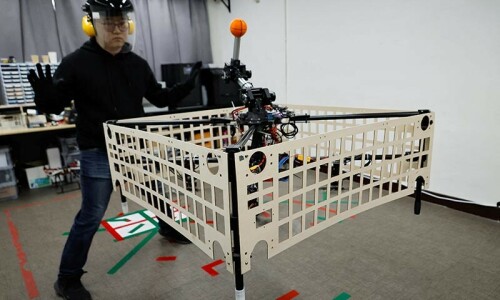Intro
As city regions increase and e-trade maintains growth, innovation in transport technology is becoming essential. South Korean scientists designed an innovative drone, regularly dubbed the “flying purchasing cart,” that may considerably enhance the way items are transported, particularly in hard urban environments.
The Flying Shopping Cart Concept
The flying shopping cart isn’t always only a standard drone but a more sophisticated, independent shipping machine capable of carrying mild items over complicated terrains, along with stairs and uneven surfaces. Developed by way of a tech team from the Seoul National University of Science and Technology, this innovation makes use of advanced algorithms and bendy rotors to stabilize itself mid-air. This drone dynamically adjusts to maintain its stability, offering a smoother and more secure transport technique than traditional drones limited by their rigid structure.
How the Flying Shopping Cart Works
The drone has a flat platform on a pinnacle where users can place goods or programs. Its unique feature is that users can control it via a handlebar, imitating the feel of a real shopping cart, but instead of pushing it on wheels, users guide it through the air. This layout ensures that the drone can maneuver seamlessly through environments wherein wheeled transportation could fail, along with stairs or bumpy terrain.
Professor Lee Jae, a mechanical device layout engineering professional, defined the drone as operating on the concepts of bodily human-robotic interaction.
This allows the machine to interpret and respond to the user’s guidance, making the flight more intuitive and reliable. As such, it is not purely an automated system but blends human input with machine efficiency.
The Technology Behind the Flying Shopping Cart
At the heart of this innovation is its dynamic rotor system. The drone’s rotors can tilt and adjust mid-flight, helping it navigate tricky environments without losing balance. Furthermore, its stabilization system is supported by an advanced algorithm that detects shifts in weight distribution and adjusts accordingly. This ensures that packages are transported smoothly and securely, even when the drone needs to ascend or descend stairs.
What units this drone apart from different transport technology is its ability to engage physically with humans. Users can guide the drone like a traditional purchasing cart, albeit in the air, making it a long way extra person-pleasant than fully self-sufficient shipping drones.
Potential Applications of the Flying Shopping Cart
While this invention remains in its developmental segment, the potential packages are huge. Imagine being able to store in a mall and no longer desiring to push a heavy cart up and down flooring. This drone could carry your items while you guide it through the air, reducing physical effort. Alternatively, for e-commerce organizations, the flying purchasing cart may be deployed to deliver packages immediately to flats positioned in excessive-upward push buildings, casting off the want for delivery personnel to climb stairs or navigate complicated entryways.
Additionally, the flying purchasing cart may be a game-changer in areas in which traditional delivery structures battle. For instance, in crowded city settings, the drone’s capacity to fly over boundaries which includes cars, pedestrians, or other boundaries should considerably reduce shipping times. Similarly, in catastrophe-stricken areas or locations with poor infrastructure, this flying cart will be used to supply important supplies like meals and medicine.
Environmental Benefits and Challenges
One of the huge benefits of the flying shopping cart is its capability and environmental impact. Traditional delivery methods, which rely upon gas-powered motors, contribute to city congestion and pollutants. Those evaluating the drones are using electric-powered options, which makes them a greener choice. As cities around the world adopt smart-city initiatives, incorporating drone technology into daily logistics could greatly diminish the carbon footprint of delivery systems.
The flying shopping cart still needs to overcome several challenges before it can be widely adopted. For one, there are concerns concerning safety, in particular in crowded urban environments. Though the drone has sophisticated sensors and algorithms, making sure it does not collide with obstacles or human beings can be paramount. Moreover, regulatory frameworks for such drone technologies are nevertheless in their infancy in lots of components of the sector. Governments would want to establish clear guidelines on wherein and how those drones can function to ensure public protection.
South Korea’s Leadership in Drone Innovation
South Korea is unexpectedly becoming a hub for the modern generation in various sectors, inclusive of robotics and AI. The flying shopping cart is just one instance of the kingdom’s ambition to lead in tech-driven solutions. With heavy investments in research and improvement, South Korea is placing the level for drones to play an extra considerable function in everyday existence. As cities become more densely populated, innovations like the flying shopping cart will redefine how humans consider shopping, delivery, and urban mobility.
South Korean scientists and engineers showcase the ingenuity of this flying drone generation, providing a glimpse into the future of automated deliveries. The project highlights South Korea’s dedication to developing smart solutions that blend comfort with sustainability.
Conclusion:
Drones may soon assist with grocery delivery and retail tasks, reducing human labour. However, emerging technologies need to overcome hurdles, including regulatory challenges and safety concerns.
In our convenience-driven world, the flying shopping cart could revolutionize everyday tasks. South Korea’s innovation will transform the transport of goods in e-commerce, personal shopping, and emergency supplies.
Related Videos:
Keywords:
- South Korea flying shopping cart
- flying shopping cart technology
- South Korea drone innovation
- sustainable delivery solutions
